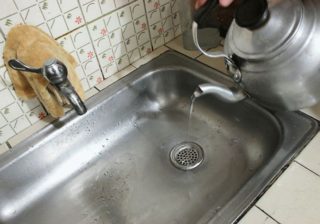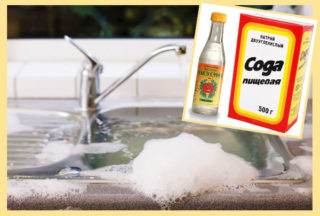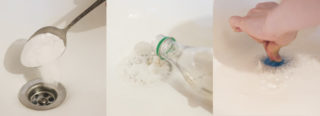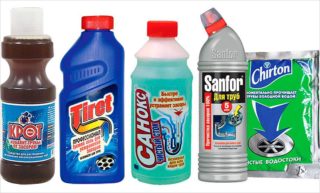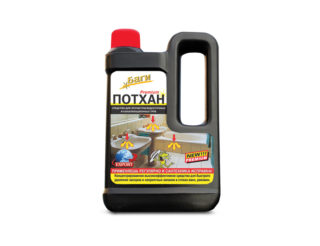Clogged sewer pipes at home are not uncommon. This happens both in the bathroom and in the kitchen. In the first case, the cause may be hair stuck in the drain and some cleaning products. Large amounts of edible grease and small food residues get into the kitchen sink, which collect like plaque on the inside of the pipes and clog them. You can get rid of such problems on your own. There are many effective ways to do this, which will be discussed later.
Hot water and boiling water
- The blockage must be fresh.
- The exposure to water must be long enough.
The second condition is also created by the main disadvantage of this method. If hot water appears in your home thanks to a boiler, then most likely you will have to spend most of its contents to remove the blockage, which may not always be acceptable.
This method has one more nuance. Before proceeding with it, check exactly where the blockage is. If the water decreases, but very slowly, then the blockage is at a distance of about 1 meter from the siphon. In this case, using hot water will be quite appropriate. If the water from the sink does not leave at all or gets stuck at a certain level, then boiling water cannot break through the resulting plug.
Step-by-step instruction:
- Turn on the hot water tap and fill the sink with boiling water.
- Wait until the water is completely gone, and repeat the procedure.
- Fill the sink with hot water until it runs out freely, without any obstruction.
Soda and vinegar
Please note that when reacting, baking soda and vinegar release corrosive substances that can easily poison a person. Therefore, always have something ready to plug the drain tightly when using these recipes.
Recipe number 1
You will need:
- Half a bag of soda.
- 100 ml vinegar.
- 2 liters of hot water.
Pour the baking soda into the pipe, then gently add the vinegar there. As soon as a reaction starts, cover the drain with a rag or lid. As you already know, this is necessary to protect the room from harmful substances released when combining soda and vinegar. After 20-30 minutes, open the drain and spill it with hot water.
Recipe number 2
You will need:
- 100 g soda.
- 100 ml vinegar.
- 2 liters of hot water.
Gently mix the vinegar and baking soda in a glass or earthenware container, then drain the mixture into the drain. Then close the drain with a cloth or lid. After 1.5-2 hours, pour boiling water over the pipe.
Salt and soda
Recipe number 1
You will need:
- 350 gr. coarse salt;
- 200 gr. soda;
- 300 ml. hot water.
Pour salt into the drain, then soda, pour boiling water over everything and leave for 20 minutes.Then pour hot water over the pipe. If the blockage persists, repeat the procedure.
Recipe number 2
If you add vinegar to soda and salt, then the effect of the product will increase several times.
You will need:
- 200 gr. salt;
- 200 gr. soda;
- 10 ml. vinegar;
- 2 liters of hot water.
Pour loose components into the pipe and pour everything with vinegar. When a reaction starts, cover the pipe with a rag. After 1 hour, pour hot water over the drain.
Will specialized household chemicals help?
Mr. Muscle
This tool is inexpensive and does an excellent job of dealing with problems. Besides removing blockages, Mister Muscle also disinfects the pipe surface. This tool is quite simple to use:
- Pour the contents of the bag into the tube.
- Pour in 250 ml powder carefully. warm water.
- After half an hour, thoroughly rinse the sink or bathroom drain.
One bag is enough for you to completely eliminate pipe problems.
Mole
A remedy from a domestic manufacturer, which costs no more than 80 rubles, while it can be very effective. Its only drawback: for the remedy to work, at least 2 hours must pass.
How to use the Mole:
- Pour in 200-250 ml. the contents of the bottle into the drain;
- Leave the product on for 2 hours;
- After that, thoroughly flush the pipe with a powerful pressure of water.
If necessary, use "Mole" again.
Pothan
- Pour 100 ml into the tube. funds and 150 ml. boiling water;
- After 5 minutes, rinse the drain with hot water.
Flop
This remedy is quite effective even for severe blockages. It also removes hairs stuck in the bath drain. But its effectiveness is compensated by causticity, so wear protective gloves, an apron and glasses before starting the procedure.
How to use:
- Pour in 300-400 ml. funds in the drain;
- Add 500 ml. hot water;
- After 5 minutes, rinse the drain thoroughly with cold water.
For different types of blockages, there may be a different dosage of water and "Flup", therefore, carefully read the instructions written on the packaging of the product before use.
How to prevent further clogging
To prevent clogging, you must regularly take care of the cleanliness of the sewer pipes. To do this, it is enough to rinse them with plenty of boiling water once or twice a week. You can simply leave the hot water tap open for 30-60 minutes. Boiling water will clean the inner side of the pipes by itself, removing fat and surfactant residues from the cleaning agents from it.
To protect the pipe in the kitchen from blockages, you should carefully monitor what goes into the sink with dirty dishes. Never leave food leftovers on dirty dishes, otherwise they will quickly create a greasy plug in your drain or simply clog the siphon, which you then have to disassemble, and this is not so easy to do.
It is even better if you leave the hot water tap open for a short time after each dishwashing. Alternatively, you can spill the drain with boiling water from a kettle if you have a boiler and save hot water.
A clogged pipe is always inconvenient. Especially if this happens in the midst of cooking or washing dishes. Do not put off removing the blockage, especially since it is quite simple to do it. Better yet, try to take care of the cleanliness of the siphon and drain in advance, so as not to resort to various means of cleaning them.

